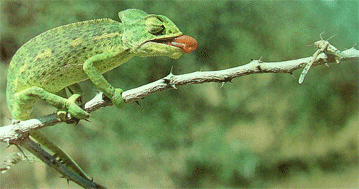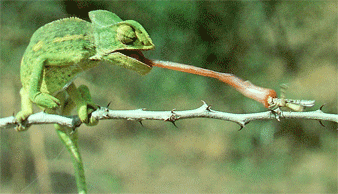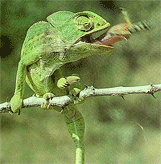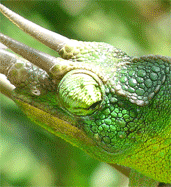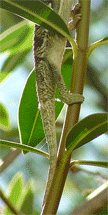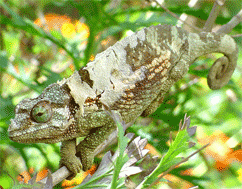|
|
||
|
|
Jackson male catching a fly from a flower The chameleons' favourite food are sweat juicy flies - and their favourite hunting ground to find the flies is to hide among the leaves and branches of a tree or bush in flower, so that they can catch and eat the flies. The chameleon has a very long tongue which it keeps rolled up in the bottom on its' mouth. When it sees a fly or other insect, it turns it's body around to face it, very very slowly. It looks at the insect with both eyes, while it slowly opens it's mouth, and darts its' long tongue out to catch the insect. It curls its' tongue back into its' mouth with the insect hidden inside its tongue, and eats it.
|
Photos above courtesy of 'Chameleons' by Claudia Schnieper and Max Meier |
|
The chameleon has 5 fingers on each hand and 5 toes on each foot. These are separated so that the chameleon can grip onto a branch tightly. Each toe ends in a sharp nail which is also developed to help the chameleon to hold on. |
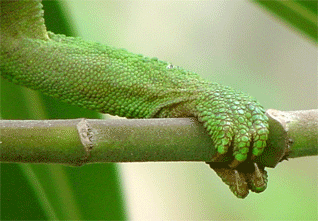 |
|
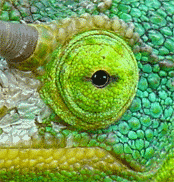
 The chameleon looks forwards, up, back and down!
|
The chameleon is very unusual in that it can move each of its' two eyes independently of each other. That means that it can be looking at 2 different things at the same time! It uses this technique to look for it's food, and keep a good look out for predators. Chameleons also have telephoto vision, which means they can magnify things that are far away so that they can see them better. Once the chameleon has found something to watch, or even better to eat, both eyes then turn to focus on the same thing.
|
|
|
The chameleons' tail has two main functions, the first is for balance, and the second is for support. It curls it's tail when it is sitting still on a branch - lowering it's centre of gravity and therefore giving the chameleon greater balance. When it is moving along a branch it stretches out its tail behind its body along the branch to give it greater support and to stop it falling off!
|
|
|
|
|
Chameleons shed their skin as their body gets too big for it, as it does not grow along with the body. The skin is made up of keratin, which is colourless material, but it can not stretch. As the body gets bigger, the skin molts, and come off piece by piece, and another new skin can be seen underneath the molting skin.
|
|







